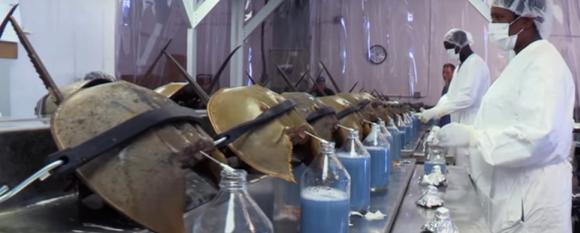 Horseshoe crabs are an ancient variety of arthropods, which are not actually crabs. Having remained largely unchanged in about 450 million years, the horseshoe crab is considered by many to be a living fossil. One of the reasons that horseshoe crabs have survived so long is that they have a highly robust immune system. Indeed, the horseshoe crab’s bright blue blood has remarkable antibacterial properties.
Horseshoe crabs are an ancient variety of arthropods, which are not actually crabs. Having remained largely unchanged in about 450 million years, the horseshoe crab is considered by many to be a living fossil. One of the reasons that horseshoe crabs have survived so long is that they have a highly robust immune system. Indeed, the horseshoe crab’s bright blue blood has remarkable antibacterial properties.
The good news for humans, and the bad news for horseshoe crabs, is that amebocytes in the horseshoe crab blood are highly sensitive to time amounts of bacteria and will coagulate around as little as one part in a trillion of bacterial contamination. Limulus Amebocyte Lysate, or LAL, a compound processed from horseshoe crab blood is used to test for contamination of anything that might go inside the human body: every shot, every IV drip, and every implanted medical device.
Bigthink.com reports that LAL has become nearly as valuable as gold. Thanks to the ubiquity of endotoxins and the dire need to test for their presence, a quart of horseshoe crab blood could fetch $15,000. Given that millions of human lives are probably saved yearly by horseshoe crab blood, the expense is well worth it. The problem is that we may be killing too many horseshoe crabs in the process.
Pharmaceutical companies harvest as many as 600,000 horseshoe crabs a year. Like some sort of weird new-age vampires, Big Pharma drains up to 30% of the blood from the crabs before returning them to the ocean. Many do not survive the treatment. Estimates of survival rates vary wildly. Some official sources put the death rate at around 3 or 4%, but these figures typically represent only deaths directly resulting from transportation and handling. Other organizations put the mortality rate as high as 30%. There are serious concerns that the blood harvesting is killing more horseshoe crabs than can reproduce.
The really good news on the horizon is that the Big Pharma horseshoe crab vampires’ days may be numbered. A synthetic equivalent to LAL processed from insects who happened to be distant cousins to the horseshoe crabs, appears to be as effective as the real thing processed from horseshoe crab blood.

“killing too many horseshoe crabs in the process” means no, it’s not worth it.